Use this information sheet for a good brine formula prior to smoking the salmon: Home Canning Smoked Fish and Home Smoking Fish for Canning
[Editor’s note: this is a good story and the information regarding the canning process is reliable, except for the brine recipe itself. The fish ended up tasting way too salty. Use the information below to get a sense of the overall process, use the brine recipe referenced above.]
A boatload of fresh Alaskan Copper River salmon arrived in the mail.
Actually, it was roughly 12-15 pounds of filleted cuts of Coho (Silver), Sockeye, Pinks (Humpys) and Keta (formerly called Chum)—but from my perspective it felt like a commercial haul had landed upon our doorstep. By far, the Chum contained the biggest size fillets, perhaps weighing as much as 2-3 pounds per fillet, and each type of fish was distinguishable by differing shades of red and pink colors. The Sockeye had the deepest red meat, and contained the most oils (the omega-3’s among them). Of the lot, the Sockeye are considered the most prized for eating fresh, smoking, and ultimately, for my own goal— canning them for later consumption during the long winter months that lie ahead.
This cargo of Salmon came from Cordova, Alaska, courtesy of the Copper River Marketing Association that represents the fisherman in that region. We were part of a media tour to learn more about the fascinating Copper River salmon and their unique ecosystem that supports the fish and is the lifeblood of the local community (a CUPS video to follow in a few weeks). The salmon were part of a haul that we caught on board the “Paradigm Shift”, a commercial gill net fishing vessel designed by its owner Bill Webber, who along with his wife Laurie, and crew-hand Todd Blaisdell, were kind enough to show us how a commercial fishing boat operates on the Gulf of Alaska. Of course, Rebecca and I played no direct part in the catching of these fish—we were out in the Copper River Delta between salmon fishing runs, the Sockeye had largely passed through (to continue on their arduous journey 300 miles upstream to reach their spawning grounds), and the Coho were days away from their expected run—so this was really a demonstration run, a perfect time to host a group of journalists that knew little about commercial salmon fishing.
As for the drying and curing stage, and the subsequent smoking that were done on the fish, I make no representations of being an expert in these two different processes. Indeed, though I have barbecued for many years, and learned a tremendous amount from some highly skilled barbecue competition cooks, and have extensively barbecued whole king salmon before (until kings became so hard to purchase, and expensive), I have never smoked any type of fish before. While there are many types of commercial smokers that are designed mainly for smoking purposes, I used a Texas style offset cooker (made by Horizon in Oklahoma) that worked beautifully for my purposes here. The challenge was to keep the smoke going at a relatively low temperature, 100 degrees F. for 4 hours. Had I not been canning, I would have gone to 8 hours of smoking and gradually increase the smoking temperature to 140 F.
By contrast, the pressure-canner process was done with a food preservation expert, Harriet Fasenfest, and along with the separate video excerpt (Harriet with Marge Braker, a retired OSU extension food preservation educator) shows the basic operation of a pressure-canner needed for canning any type of low acid food. The entire curing, smoking, and subsequent canning process took just 3 days to complete. Rebecca worked the hands-on during the canning stage, all the photos were taken by me.
Here are the following steps, and curing recipe:
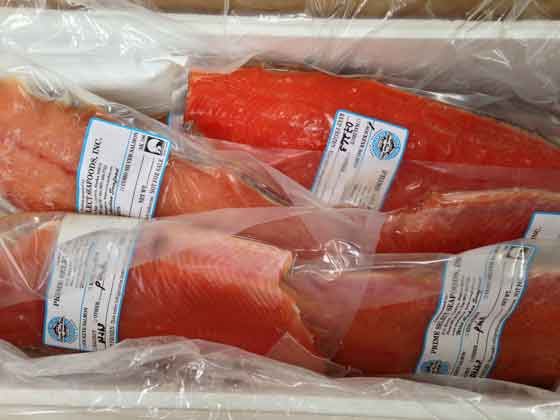
Open shipment of fresh, Copper River salmon that arrived in the mail.
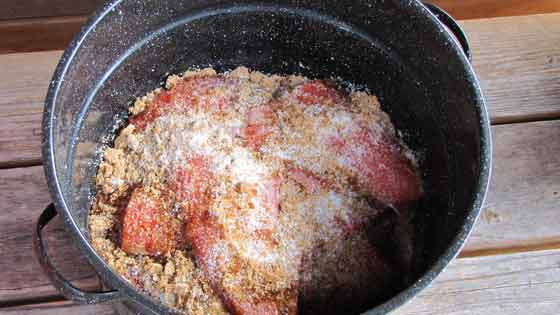
The fish came already filleted, on each side, the outer skin remained attached on both pieces. The curing recipe came from the internet, essentially 2 parts brown sugar to 1 cup (non-iodized) salt. I used almost 2 boxes of coarse kosher salt, and about 3 pounds of pure cane brown sugar. If you use 1 cup of salt, add in 2 cups of brown sugar for these proportions. Make sure to mix ingredients together before adding to fish.
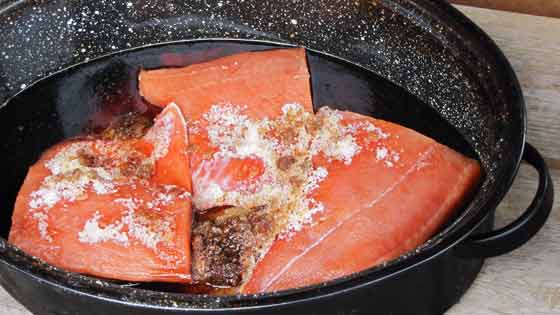
24 hours later—a shocker! I had covered the fish in layers with the salt/sugar mixture, after removing from the refrigerator the next day, most of the water had been pulled out by the curing process.
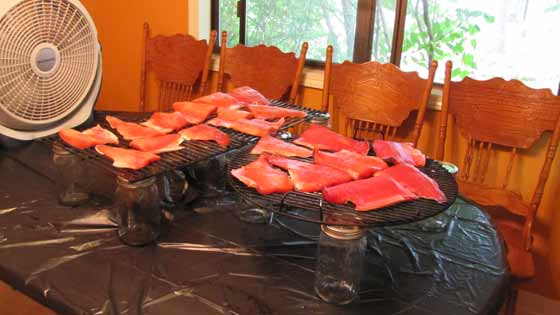
After the fish is thoroughly washed off in cold water, the individual fillets are placed on racks and dried for up to 24 hours. The goal is to dry off much of the remaining moisture on the fish; they are ready for smoking when a shiny (glossy) patina appears on the surface of the fish. I used a standard commercial fan, and mostly at medium setting, dried the fish for 24 hours. I also rotated some of the fish closest to the fan. For identification purposes, the front rack (furthest from the fan) contains the Sockeye and Coho, the left rack, the pinks, and the chum are on the back-end right rack (closer to the fan).
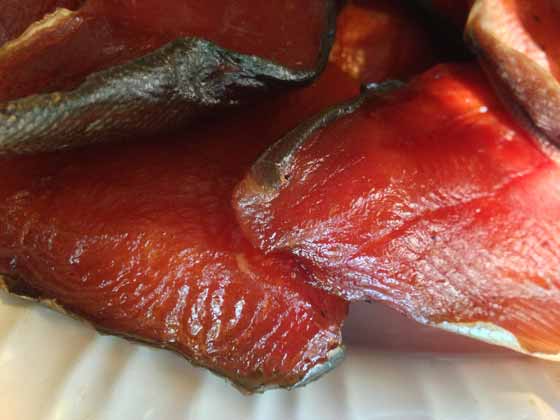
This is what the salmon looks like after the drying process has completed.
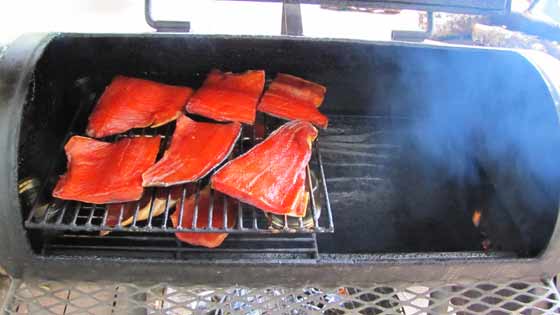
Inside the cooker, the goal was to keep the smoke coming but not produce too hot a fire in the firebox (far right). Since I was going to essentially be cooking the fish during the canning process that would follow, I worked to keep the temperature steady at 100 F. for 4 hours time. The 1/2 inch thick steel gauge cooker worked like a champ as a smoker. I used a combination of Kingsford Mesquite charcoal and dry hickory chips. Fair warning, the recipe I was following advised against mesquite— hickory, apple, cherry were all considered fine to use.

The temperature gauge on the cooker lets me know the internal temperature of the cooker.
The Canning Process:
In this short video above, Marge Braker demonstrates the basics of a pressure canner.
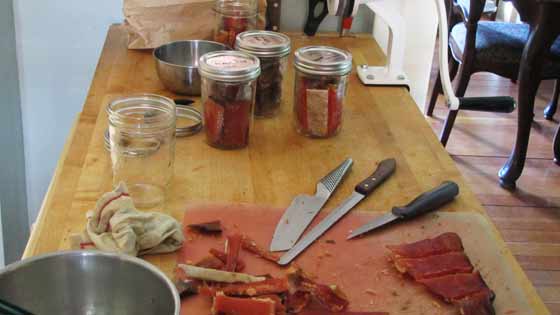
The canning jars we used were wide-mouthed pints, and each piece of fish cut into slices had to be no taller than would allow for an inch at the top of space so the jars would seal properly. It was not necessary to pack each jar so we ended up with 16 jars, the last one just contained odds and ends. As best as possible, we kept the coho and sockeye separate from the pinks and chum. After the curing and then smoking process, the differences in color between the different species appeared less discernible.

The jars are in the pressure canner. These are the canning instructions we used from Oregon State University Extension: Home Canning Smoked Fish. It’s important to note, failure to follow canning instructions, including the allowance for whether you are canning at sea level or at higher altitudes may result in death.
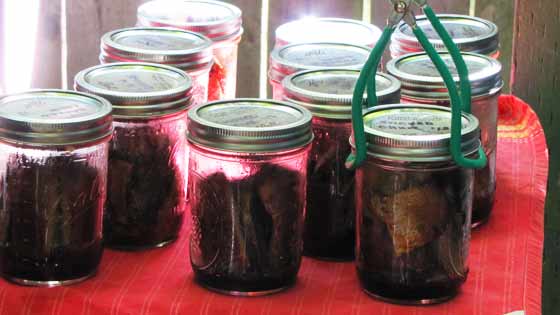
The end result!
So far, we have tasted the Sockeye, Coho, and Pinks. The pinks, the smallest of the fillets, tasted very salty and a bit dried out. The flavor was still pleasurable but likely because I love the taste of salmon. Next time, I will try curing the pinks for 6 hours, not 24 hours, and maybe choose instead to smoke them at higher temperatures (140-160 F) for longer times ((8 hours), and not can them. The Sockeye and Coho tasted moist and delicious (probably because they contain more oils, not just their size), and not too salty. By the way, smoking fish only preserves the fish for up to 2-3 weeks in the refrigerator. According to the extension brochure, only by freezing or canning the fish can it safely be stored for longer periods of time.
What a learning process. Looking forward to next year, we have to keep doing this until the process has been perfected.
This post was written by Fred Gerendasy, a contributor to Cooking Up a Story as a writer and occasional interviewer. His current work is featured at Fred Gerendasy Photography.
